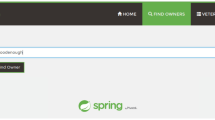Abstract
Use cases have gained wide acceptance since the standardisation of the UML by the Object Management Group in 1997. This paper addresses the inadequacy of use cases for expressing intra-use case and inter-use case dependencies. We present a state-based approach for facilitating explicit consideration of such dependencies in use case descriptions, and a support tool is described, which provides enaction of the state-based use cases to support validation. We outline an industrial study involving the specification of real-time monitoring systems, wherein we demonstrate that enaction of the state-based use cases highlighted important dependency issues that had not been revealed within standard use cases.












Similar content being viewed by others
References
Broy M (2006) The ‘grand challenge’ in informatics: engineering software-intensive systems. IEE Comput Soc 39(10)
Maiden N, Robertson S (2005) Developing use cases and scenarios in the requirements process. In: 26th International conference on software engineering. ACM press, New York
Cheng B, Atlee JM (2007) Research directions in requirements engineering. In: Future of software engineering, Minneapolis, MN, USA
Some S (2005) Use cases based requirements validation with scenarios. In: The 13th IEEE international conference on requirements engineering. IEEE Computer Society, Paris
Maiden N, Robertson S (2005) Developing use cases and scenarios in the requirements process. In: IEEE international conference on software engingeering
Subramaniam K et al (2004) UCDA: Use case driven development assistant tool for class model generation. In: The 16th international conference on software engineering and knowledge engineering, Banff, Canada
Rysavy O, Bures F (2004) Formal abstract architecture for use case specifications. In: 11th IEEE international conference and workshop on the engineering of computer-based systems
Cox K, Aurum A, Jeffery R (2003) A use case description inspection experiment. In: 8th Australian workshop on software requirements, Sydney, Australia
Rolland C, Achour B (1998) Guiding the construction of textual use case specifications. CREWS report series
Regnell B (1999) Requirements engineering with use cases—a basis for software development. In: Department of Commnunication Systems, Lund Institute of Technology. Lund University, Sweden
Cockburn A (2001) Writing effective use cases. Addison-Wesley, Reading
Cox K (2002) Heuristics for use case descriptions. In: Design, engineering & computing. Bournemouth University, UK
Sutcliffe A et al (1998) Supporting scenario-based requirements engineering. IEEE Trans Softw Eng 24(12):1072–1088
Sutcliffe A (1998) Scenario-based requirements analysis. Req Eng J 3:48–65
Elkoutbi M, Khriss I, Keller K (2005) Automated prototyping of user interfaces based on UML scenarios. Autom Softw Eng 13(1)
Maiden N (2004) Discovering requirements with scenarios: the ART-SCENE solution. Special theme, Automated Software Enginering
OMG (2002) Unified modelling language specification version 2.0. [cited 2004 March]. Available from: http://www.uml.org/
Glinz M (2002) Statecharts for requirements specification-as simple as possible, as rich as needed. In: Proceedings of ICSE; workshop on scenarios and state machines; models, algorithms and tools
Uchitel S, Kramer J, Magee J (2003) Synthesis of behavioural models from scenarios. IEEE Trans Softw Eng 29(2)
Uchitel S, Robert C, Jeff Kramer JM (2006) Goal and scenario validation: a fluent combination. Req Eng 11(2)
Phalp K, Henderson P, Abeysinghe G, Walters B (1998) RolEnact: role-based enactable models of business processes. Inform Softw Technol J 40(3)
Zimmerman MK, Lundqvist K, Leveson NG (2002) Investigating the readability of state-based formal requirements specification languages. In: International conference in software engineering, Florida, USA
Harel D, Marelly R (2001) Capturing and executing behavioral requirements: the Play-In/Play-Out approach. The Weizmann Institute of Science, Rehovot
Rolland C (2002) L’E-Lyee: coupling L’Ecritoire and LyeeALL. Inform Softw Technol J 44(3)
BetterHealthChannel. Artificial cardiac pacemakers. [Internet site] 2001 [cited 2004; Available from: http://www.betterhealth.vic.gov.au/bhcv2/bhcarticles.nsf/pages/Artificial_cardiac_pacemakers?open
Douglass BP (2000) Real-time UML: developing efficient objects for embedded systems. Addison-Wesley, Reading
Seybold C, Meier S, Glinz M (2004) Evolution of requirements models by simulation. In: International workshop on principles of software evolution, Kyoto, Japan
Eshuis R, Wieringa R (2004) Tool support for verifying UML activity diagrams. IEEE Trans Softw Eng 30(7)
Heymans P, Dubois E (1997) Some thoughts about the animation of formal specifications written in the Albert II language. In: 3rd IEEE international symposium on requirements engineering
Magee J et al (2000) Graphical animation of behavior models. In: Proceedings of the 22nd international conference on software engineering
Jacobson I (1992) Object-oriented software engineering: a use case driven approach. Addison-Wesley, Wokingham
Jacobson I ed (1995) The use case construct in object-oriented software engineering. In: Carroll JM (ed) Scenario-based design: envisioning work and technology in system development. Wiley, New York
Homrighausen A, Six H, Winter M (2001) Round-trip prototyping for the validation of requirements specifications. In: Requirements engineering: foundations for software quality. Interlaken, Switzerland
Jørgensen JB, Bossen C (2004) Executable use cases as links between application domain requirements and machine specifications. In: 3rd international workshop on scenarios and state machines (at ICSE04), Edinburgh, Scotland
Author information
Authors and Affiliations
Corresponding author
Rights and permissions
About this article
Cite this article
Kanyaru, J.M., Phalp, K. Validating software requirements with enactable use case descriptions. Requirements Eng 14, 1–14 (2009). https://doi.org/10.1007/s00766-008-0070-8
Received:
Accepted:
Published:
Issue Date:
DOI: https://doi.org/10.1007/s00766-008-0070-8




